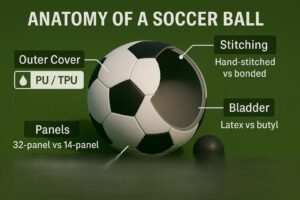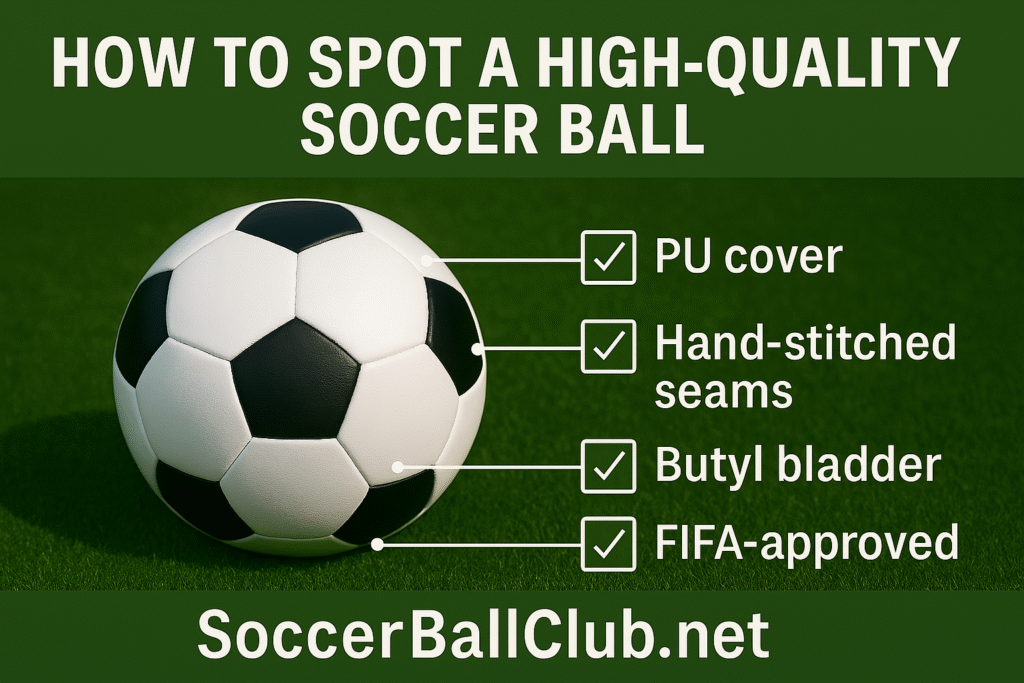Introduction
Not all soccer balls are created equal. From material to stitching, the smallest details can make a huge difference in performance and durability.
At SoccerBallClub.net, we believe every player deserves a ball that performs — whether you’re training, playing in a league, or just kicking around.
In this expert guide, we break down how to spot a high-quality soccer ball before you buy.
Look for Durable Outer Material
The outer layer, also called the cover, is your first line of defense. A high-quality ball should be made from:
- PU (polyurethane): Premium feel, soft touch, and great durability
- TPU (thermoplastic polyurethane): Slightly firmer, more affordable, still long-lasting
Avoid PVC balls for match play — they’re often too hard and wear quickly.
At SoccerBallClub, we use PU and TPU blends tested for 100+ hours of use.
Check the Panel Construction
Soccer balls are made of panels stitched or bonded together.
Common types:
- 32-panel (classic)
- 18-panel / 14-panel (modern flight optimization)
Also, pay attention to how the panels are joined:
- Hand-Stitched: Flexible and highly durable
- Thermally Bonded: Seamless and waterproof
- Machine-Stitched: Cheaper, not as long-lasting
Tip: For training and matches, go for hand-stitched or bonded balls. Explore our hand-stitched vs bonded guide.

Inspect the Bladder Type
The bladder holds the air — and it matters more than you think.
- Latex bladder: Better bounce and softer touch, used in match balls
- Butyl bladder: Superior air retention, used in training balls
High-quality match balls usually feature latex bladders for responsiveness, while butyl is great for low-maintenance use.
Confirm FIFA or IMS Certifications
Serious about performance? Look for quality standards:
- FIFA Quality Pro: Top-tier certification
- FIFA Quality: Excellent for amateur leagues
- IMS (International Match Standard): Trusted quality
These badges mean the ball passed tests for:
- Shape retention
- Water absorption
- Bounce consistency
Our Precision Flight Pro Match Ball meets or exceeds these certifications.
Feel the Weight and Balance
A quality soccer ball should:
- Weigh between 410–450g (Size 5)
- Feel evenly balanced when kicked or held
Give it a spin — if it wobbles, it’s poorly balanced.
Tip: Test spin and bounce when possible before buying.
Check Stitching Quality (If Applicable)
For hand-stitched balls, look at:
- Even seam alignment
- Strong, tight stitching
- Reinforced thread material (often polyester)
Loose threads = short lifespan.
Our Elite Grip Training Ball is double-stitched for extreme durability.
Examine the Shape and Roundness
A high-quality ball should:
- Be perfectly spherical
- Hold its shape under pressure
- Pass the “eye-roll test” (rolls smoothly on a flat surface)
Poorly made balls can feel lopsided, affecting your control and flight.
Ask About Air Retention
Even the best ball is useless if you have to pump it every session.
Butyl bladders should retain air for 2–4 weeks. Latex bladders: 1–2 weeks.
All SoccerBallClub balls are tested for air retention, so you’re not chasing a pump every game.
Consider the Surface You’ll Play On
Different balls suit different surfaces:
- Grass/turf: Standard PU match balls
- Indoor: Low-bounce felt or foam cover
- Street/concrete: Durable rubber casing
We clearly label surface compatibility on every product page at SoccerBallClub.net.
Read Reviews and Compare Brands
Finally, trust the players. Verified customer reviews can reveal:
- Long-term durability
- Air retention
- Touch and feel feedback
At SoccerBallClub, we pride ourselves on real testimonials from real players.
Final Thoughts
A high-quality soccer ball isn’t just about looks — it’s about what’s inside. From material to construction, every detail affects your performance.
Use this checklist to make a smart, lasting choice.
Ready to upgrade your game? Explore top-tier balls at SoccerBallClub.net today.

